1. Introduction
Welcome to our comprehensive guide on GetResponse, a powerful marketing platform that can help businesses of all sizes and needs to create effective email marketing and marketing automation campaigns. In this guide, we'll explore the various features and functionalities of GetResponse, from list management and performance analysis to automated workflows and sales funnels. We'll also provide tips and best practices for getting the most out of GetResponse and optimizing your email marketing and marketing automation strategies. So let's dive in and discover what GetResponse can do for your business!
What is GetResponse? and what can it do for businesses and marketers?
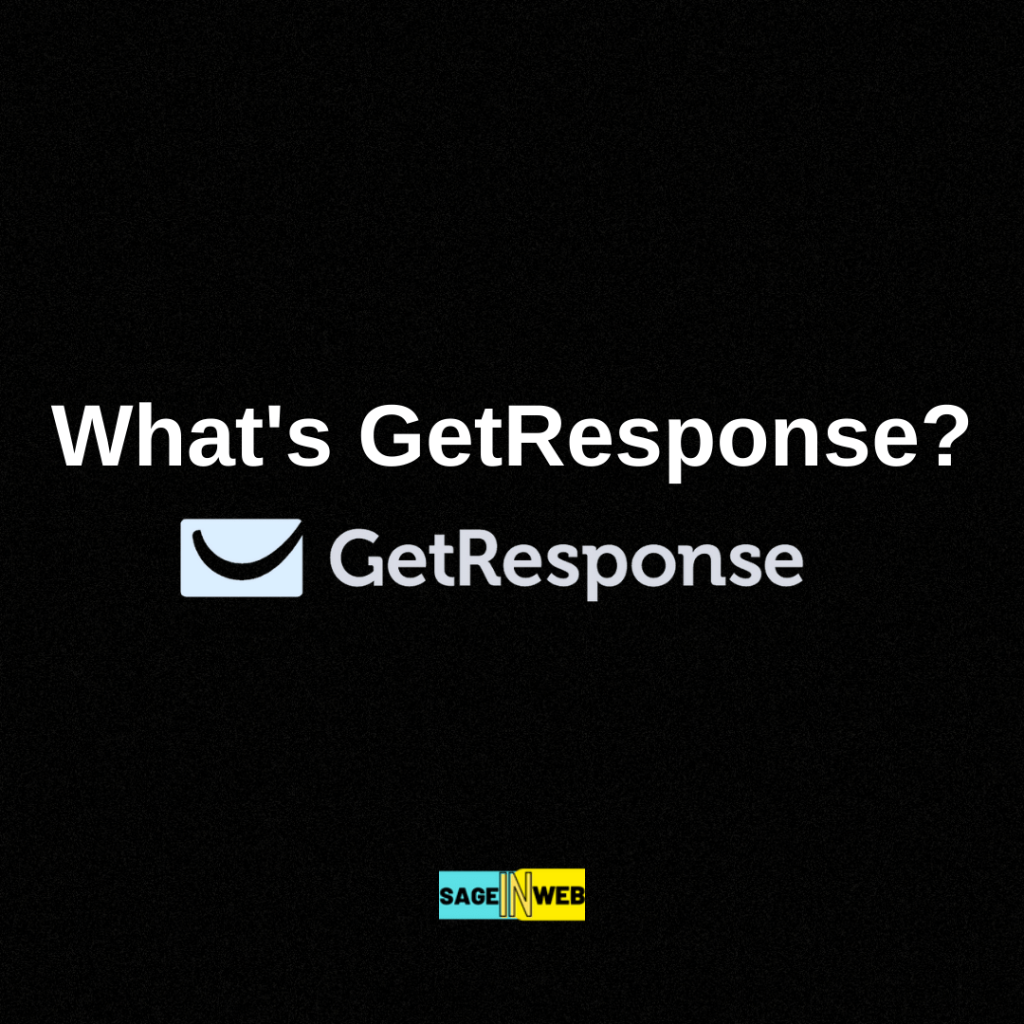
GetResponse is an all-in-one marketing platform that enables businesses and marketers to create effective email marketing and marketing automation campaigns. With GetResponse, you can manage your email lists, design and send professional-looking emails, automate your marketing workflows, and analyze the performance of your campaigns.
This platform is perfect for businesses of all sizes and needs, from small startups to large enterprises. Whether you're looking to engage with your customers through email marketing, nurture leads with targeted automation workflows, or drive sales with sales funnels and landing pages, GetResponse has you covered.
The platform is also user-friendly, making it easy for users of all skill levels to create effective campaigns that drive results. So if you want to take your email marketing and marketing automation strategies to the next level, GetResponse is worth considering.
2. Getting Started with GetResponse
If you're new to GetResponse, getting started is easy. Here's a step-by-step guide to help you get up and running in no time.
- Sign up for a free trial: The first step is to sign up for a free trial of GetResponse. That will give you access to all the platform's features and functionalities for 30 days, so you can test drive the platform and see if it's right for your business.
- Set up your account: Once you've signed up, you'll need to set up your account. That involves providing basic information about your business and creating your first email list.
- Create your first email: With your account set up, it's time to start creating your first email. GetResponse offers a variety of customizable email templates to choose from, making it easy to design a professional-looking email in minutes.
- Automate your workflows: One of the most powerful features of GetResponse is its marketing automation capabilities. To start with Automation, create a new workflow and add triggers and actions to automate your campaigns.
- Analyze your results: Once your campaigns are up and running, tracking and analyzing your results is important. GetResponse provides detailed analytics and reporting tools to help you measure your campaign's performance and identify improvement areas.
With these basic steps, you'll be well on your way to creating effective email marketing and marketing automation campaigns with GetResponse. And with the platform's user-friendly interface and powerful features, the possibilities are endless.
3. Creating and Managing Email Campaigns
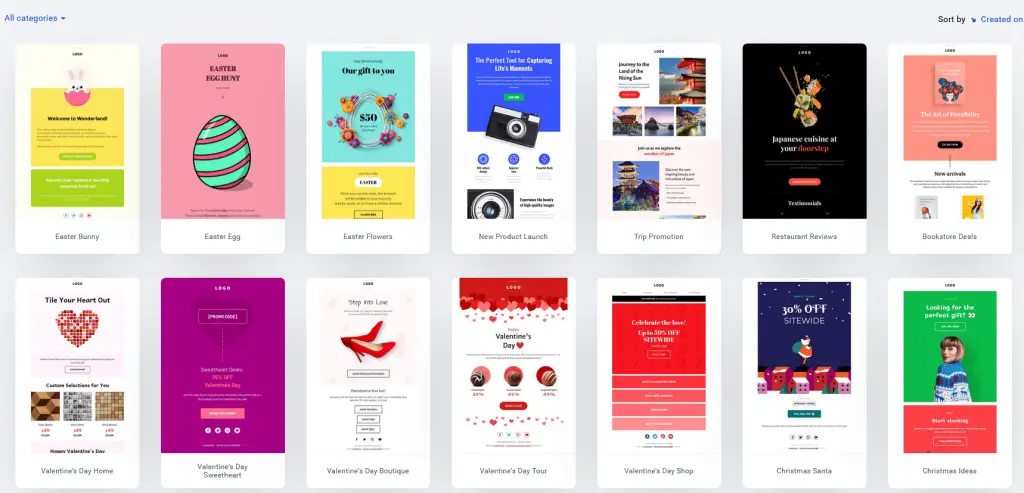
Email marketing is one of the most effective ways to engage with your customers and drive sales for your business. Here's how you can create and manage effective email campaigns using GetResponse.
- Create a new email: To get started, click on the “My Templates” button from the email marketing section of your dashboard. From here, you can choose a template or start from scratch to create a custom email that fits your brand and message.
- Customize your email: Once you've selected your template, it's time to customize your email. That involves adding text, images, and branding elements to make your email stand out and resonate with your target audience.
- Set up your list: Before sending your email, you'll need to set up your list. That involves adding and segmenting your subscribers based on their interests, behaviors, and demographics.
- Schedule and send: With your email and list set up, it's time to schedule and send your campaign. GetResponse offers a variety of scheduling options, including sending your email immediately, scheduling it for a specific date and time, or setting up an automated campaign.
- Analyze your results: Once your campaign is sent, it's important to analyze your results to see how they performed. GetResponse provides detailed reporting and analytics tools that enable you to track opens, clicks, conversions, and more.
By following these steps, you can create and manage effective email campaigns that engage with your audience and drive results for your business. With GetResponse's intuitive email builder and powerful list management and automation tools, creating effective email campaigns that drive business growth has never been easier.
3.1 GetResponse Email templates

If you're unsure where to start designing your email campaigns, GetResponse has you covered. The platform offers a variety of pre-designed email templates that you can use as a starting point for your campaigns. Here's how to use them.
- Choose your template: To start, click on the “Create email” button from your dashboard and select “From Template.” From there, you can browse through hundreds of pre-designed email templates, including newsletter templates, promotional templates, and more.
- Customize your template: Once you've selected your template, it's time to customize it to fit your brand and message. That involves adding text, images, and branding elements to make your email stand out and resonate with your target audience.
- Save your template: Once you've customized your template, you can save it for future use. That makes creating consistent branding across all your campaigns easy and saves time in the long run.
GetResponse's email templates make it easy for beginners to design professional-looking email campaigns engaging with their target audience. With hundreds of templates and easy customization options, you can create effective email campaigns quickly.
3.2 How to build and organize your email list in GetResponse?

Your email list is a crucial part of your email marketing campaign, as it contains the contacts you'll send your emails to. Building and organizing your email list in GetResponse is easy and can help you reach your target audience more effectively.
To start building your email list, create a sign-up form and place it on your website or social media pages. That will allow people interested in your content to sign up and receive your emails. You can also import contacts from other sources, such as a spreadsheet or another email service.
Once you've started building your email list, it's important to keep it organized. GetResponse offers tools to help you manage and segment your list. You can group your contacts by location, interests, or other criteria, making sending targeted emails relevant to your readers easier.
It's also important to make sure your email list is up-to-date and accurate. That means regularly removing inactive or bounced email addresses and getting consent from your contacts to receive your emails. That will help improve your email deliverability and avoid spam complaints.
Building and organizing your email list in GetResponse is important in creating a successful email marketing campaign. By growing your list and keeping it organized, you can reach your target audience more effectively and increase engagement with your content.
3.3 How to write effective email copy and subject lines in GetResponse?
Writing effective email copy and subject lines is essential to successful email campaigns. Your email copy should be clear, concise, and engaging, while your subject lines should grab your reader's attention and entice them to open your email.
It's important to understand your audience and what they're looking for. Your email should provide value to your readers, whether through sharing helpful tips or promoting a new product. Make sure your copy is easy to read and visually appealing, with images and formatting to break up the text.
When it comes to subject lines, keep it short and sweet. Your subject line should give your readers an idea of what's inside your email while also being attention-grabbing. Consider personalization, including the recipient's name, to make the email more personalized.
| Effective Email Subject Lines |
|---|
| Join us for our Spring Sale: 50% off all items! |
| Happy Birthday, Sarah! Here’s a special offer just for you. |
| Last chance to save 20% on your purchase! |
| Get a sneak peek at our latest collection before anyone else. |
| 5 proven strategies for boosting your productivity. |
GetResponse offers tools to help you optimize your email copy and subject lines. You can run A/B tests to see which subject lines and copy perform better and use analytics to see how your emails perform. You can improve your open rates and engagement with your readers by continually refining your email copy and subject lines.
Writing effective email copy and subject lines in GetResponse is important to creating a successful email marketing campaign. You can improve your email open rates and engagement by understanding your audience, keeping it concise and engaging, and using tools to optimize your content.
3.4 How to schedule and send your email campaigns in GetResponse?
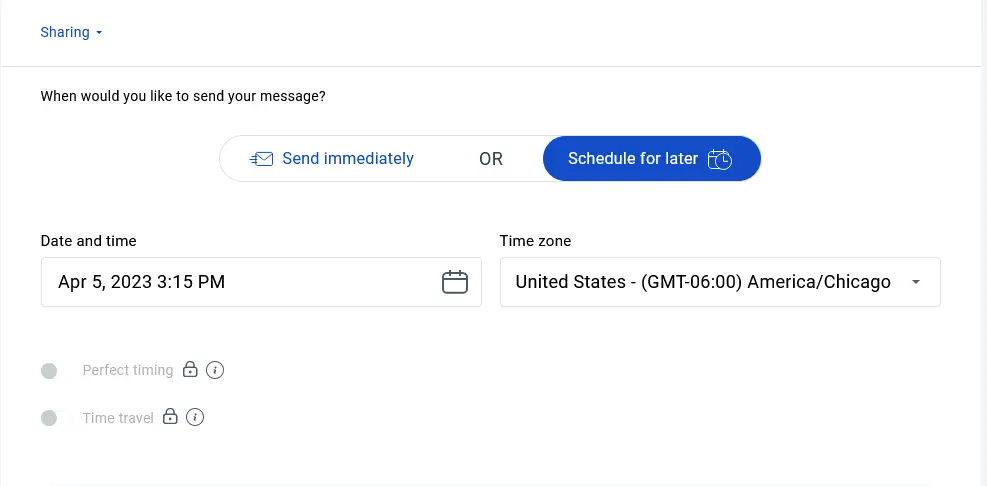
Scheduling and sending your email campaigns in GetResponse is a straightforward process. Once you've created your email content and organized your email list, you can send your emails.
To schedule your email campaign, you can use GetResponse's scheduling feature to choose the date and time you want your emails sent. That is particularly useful if you want to send your emails at a specific time, such as during peak business hours.
Once you've scheduled your email campaign, you can preview your emails and make final adjustments before sending them. GetResponse offers templates and design tools to help make your emails look professional and visually appealing.
When sending your emails, GetResponse will automatically send them to your email list at the scheduled time. You can track the performance of your emails using GetResponse's analytics tools, which show you open rates, click-through rates, and other important metrics.
It's important to remember that sending too many emails frequently can lead to reader fatigue and unsubscribes. Make sure to space out your emails and provide value to your readers with each email you send.
Scheduling and sending your email campaigns in GetResponse is a simple process. With the ability to schedule your emails in advance and track their performance, you can ensure that your emails are being sent at the right time and are resonating with your audience.
3.5 How to analyze and optimize your email performance in GetResponse?
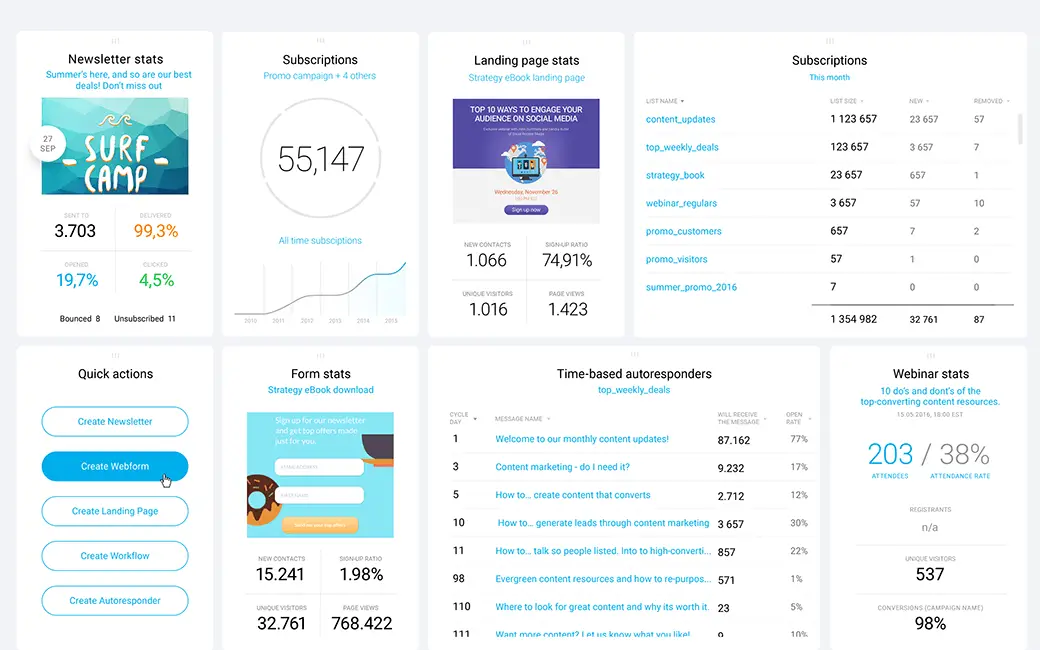
Analyzing and optimizing your email performance is important for successful email campaigns. GetResponse provides powerful analytics tools to help you track the performance of your emails and make data-driven decisions about improving your campaigns.
GetResponse's analytics tools can analyze your email performance and track important metrics such as open rates, click-through rates, and conversion rates. These metrics can help you understand how your emails resonate with your audience and identify areas for improvement.
Once you've identified areas for improvement, you can use GetResponse's optimization tools to refine your email campaigns. That may involve changing your email copy, subject lines, or visuals or adjusting your email frequency or targeting.
One key tool for optimizing your email campaigns is A/B testing. With A/B testing, you can test different variations of your emails to see which performs better. For example, you might test different subject lines or calls to action to see which drives more clicks.
By continually analyzing and optimizing your email campaigns, you can improve their performance and achieve better results over time. GetResponse makes it easy to track your progress and make data-driven decisions about how to improve your campaigns.
Analyzing and optimizing your email performance in GetResponse is critical to creating successful email campaigns. You can refine your campaigns and achieve better results by tracking important metrics, using optimization tools, and running A/B tests.
4. Automation and Autoresponders
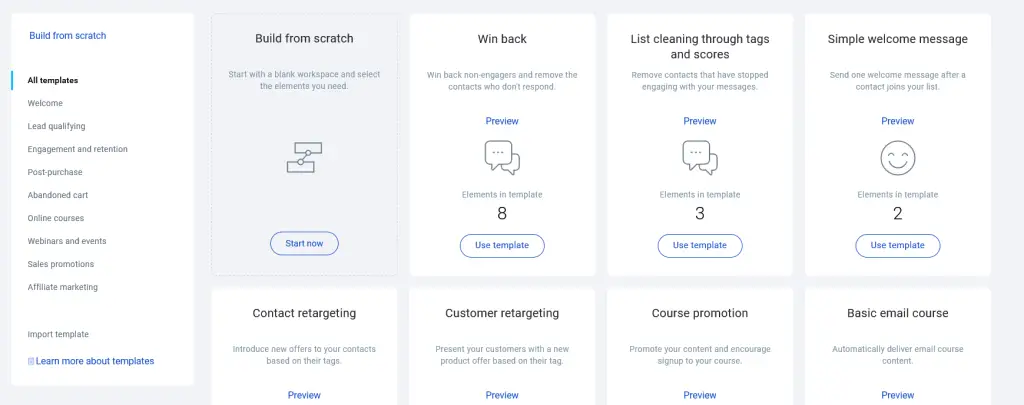
GetResponse offers a range of powerful automation and autoresponder tools that can help businesses automate their marketing tasks and streamline their workflows. Here's what you need to know about Automation and autoresponders in GetResponse.
- Automation workflows: GetResponse's automation workflows enable businesses to trigger specific actions based on user behavior, such as subscribing to a newsletter or making a purchase. These workflows can help businesses nurture leads, increase engagement, and drive conversions by delivering relevant content at the right time.
- Autoresponders: GetResponse's autoresponder tool enables businesses to automatically send emails to new subscribers, welcoming them to their email list and delivering valuable content. That helps businesses establish a relationship with their subscribers and increase engagement.
- Benefits of Automation and Autoresponders: By leveraging GetResponse's automation and autoresponder tools, businesses can save time and resources while delivering more personalized and relevant content to their target audience. That can help increase engagement, drive conversions, and ultimately drive revenue for the business.
- Performance analysis: GetResponse also offers powerful performance analysis tools that enable businesses to track the success of their automation and autoresponder campaigns. By analyzing key metrics such as open rates, click-through rates, and conversions, businesses can optimize their campaigns for better results.
GetResponse's automation and autoresponder tools are essential for businesses looking to streamline their workflows, save time and resources, and drive better results for their marketing efforts. Businesses can drive engagement, conversions, and revenue by leveraging these tools and analyzing their performance.
4.1 Understanding marketing automation and its benefits
Marketing automation is a powerful tool to help businesses automate repetitive marketing tasks and streamline workflows. Here's what you need to know about marketing automation and its benefits using GetResponse.
- What is marketing automation? Marketing automation involves using software tools to automate repetitive marketing tasks such as sending emails, managing social media accounts, and tracking website analytics. That frees up time for marketers to focus on more strategic activities and ultimately drive more revenue for their business.
- Benefits of marketing automation: Marketing automation offers a variety of benefits for businesses, including increased efficiency, improved targeting and personalization, better lead nurturing, and more effective sales processes. Businesses can save time and resources by automating these processes while driving better results.
- GetResponse's marketing automation tools: GetResponse offers a variety of powerful marketing automation tools that enable businesses to automate their marketing processes and drive better results. These include automated workflows, which enable businesses to trigger specific actions based on user behavior, and sales funnels, which guide prospects through the sales process and ultimately drive conversions.
By leveraging GetResponse's marketing automation tools, businesses can save time and resources while driving better results for their marketing efforts. With improved targeting, personalization, lead nurturing, and sales processes, marketing automation is a must-have tool for any business looking to succeed in today's competitive landscape.
4.2 Creating automated workflows and triggers in GetResponse
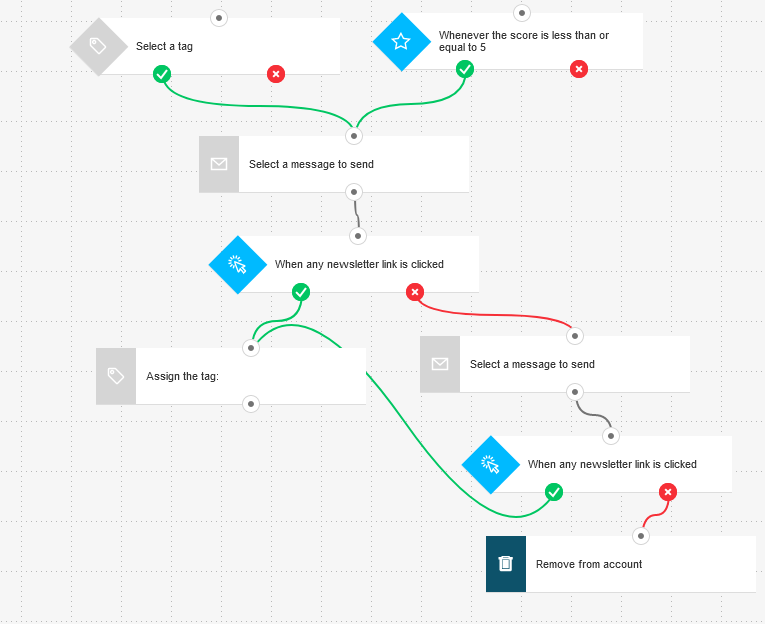
Creating automated workflows and triggers in GetResponse is a simple process that can help businesses automate their marketing tasks and deliver more relevant content to their target audience. Here's how it works:
- Identify the trigger: The first step in creating an automated workflow in GetResponse is to identify the trigger that will activate the workflow. This trigger can be a specific action the user takes, such as subscribing to a newsletter or making a purchase.
- Define the workflow: Once the trigger has been identified, businesses can define the workflow that will be activated when the trigger is activated. That can include a series of emails, SMS messages, or other actions that are designed to engage and nurture the user.
- Customize the workflow: GetResponse offers a range of customization options that enable businesses to tailor their workflows to their specific needs. That can include customizing the content of the emails, setting up segmentation rules, and defining the timing and frequency of the messages.
- Monitor performance: Once the workflow has been activated, businesses can monitor its performance using GetResponse's powerful performance analysis tools. That can help businesses optimize their workflows for better results and deliver the right content at the right time.
By creating automated workflows and triggers in GetResponse, businesses can streamline their marketing tasks, save time and resources, and deliver more personalized and relevant content to their target audience. That can help increase engagement, drive conversions, and ultimately drive revenue for the business.
4.3 Designing and managing autoresponder series in Getresponse
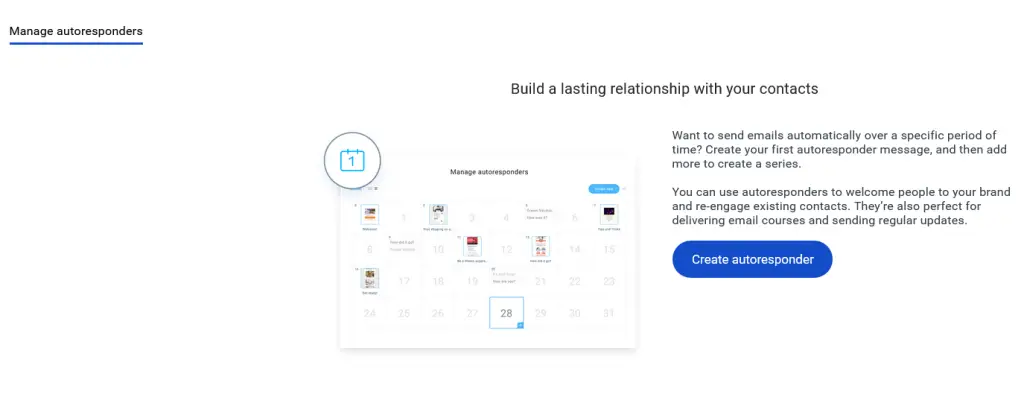
An autoresponder series is a set of pre-written emails automatically sent to subscribers at specific intervals. These emails are designed to engage and nurture subscribers and can effectively build relationships with your audience. Here's how to design and manage the autoresponder series in GetResponse:
- Define your goals: The first step in designing an autoresponder series is to define your goals. What do you want to achieve with your series? Do you want to educate your subscribers, promote a product, or drive engagement? Once you have defined your goals, you can start designing your series.
- Write your emails: The next step is to write your emails. GetResponse offers a range of customizable email templates that you can use to create professional-looking emails. You can also customize the content of your emails to match your brand and goals.
- Set your schedule: Once you have written your emails, you need to set your schedule. How often do you want to send your emails? What time of day is best for your audience? GetResponse allows you to set up a schedule that works for you and your subscribers.
- Monitor performance: Once your autoresponder series is up and running, you can monitor its performance using GetResponse's performance analysis tools. That can help you identify areas for improvement and optimize your series for better results.
By designing and managing autoresponder series in GetResponse, businesses can build stronger relationships with their subscribers, promote their products and services, and drive engagement and conversions. With customizable templates, flexible scheduling options, and powerful performance analysis tools, GetResponse creates effective autoresponder series that deliver results easily.
4.4 Using Webinars and sales funnels in Automation
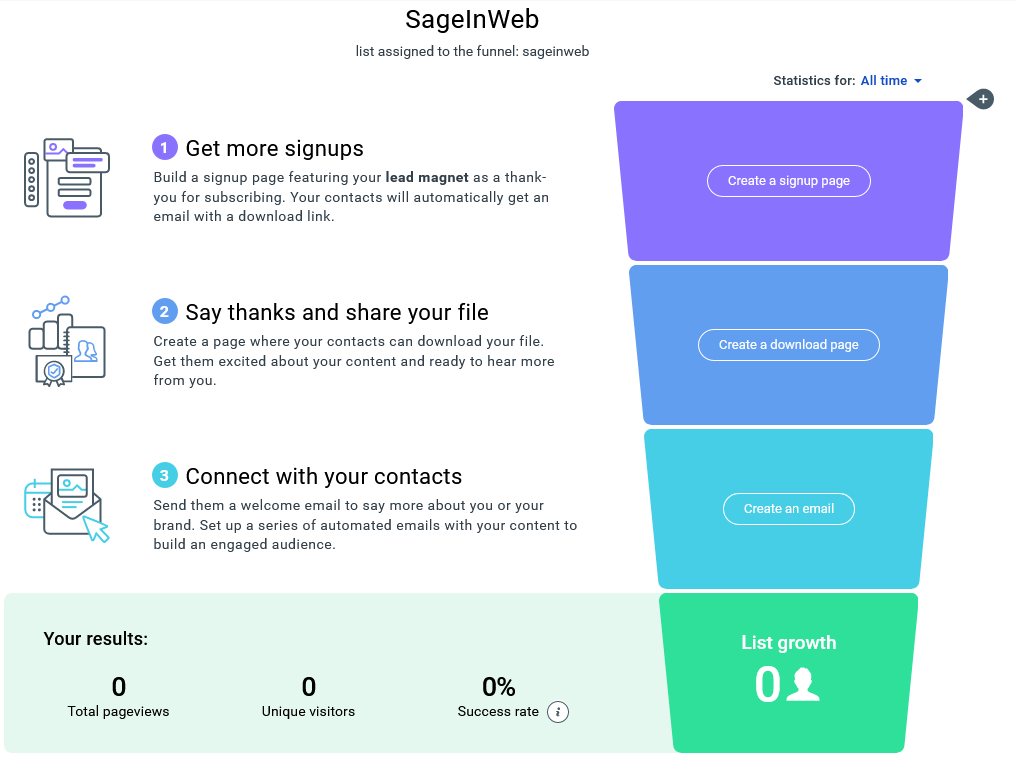
GetResponse offers powerful automation tools that can be used to create effective sales funnels and webinars. Here's how to use these features to grow your business:
- Create a webinar: Webinars are a great way to engage with your audience and build relationships. With GetResponse, you can create professional-looking webinars with customizable templates, easy scheduling, and registration management.
- Use Automation to follow up: After your webinar, you can use GetResponse's automation tools to follow up with your attendees. That can include sending them a thank you email, providing additional resources, or promoting your products or services.
- Build a sales funnel: Sales funnels are a powerful way to guide your audience through buying. With GetResponse, you can create custom sales funnels that include landing pages, lead magnets, email sequences, and more.
- Use Automation to nurture leads: Once a lead enters your sales funnel, you can use GetResponse's automation tools to nurture and guide them toward a sale. That can include sending them personalized emails, providing helpful resources, or promoting your products or services.
Businesses can use webinars and sales funnels in Automation to engage with their audience, nurture leads, and drive conversions. With GetResponse's customizable templates, scheduling tools, and automation features, creating effective webinars and sales funnels has never been easier.
5. Landing Pages and Forms
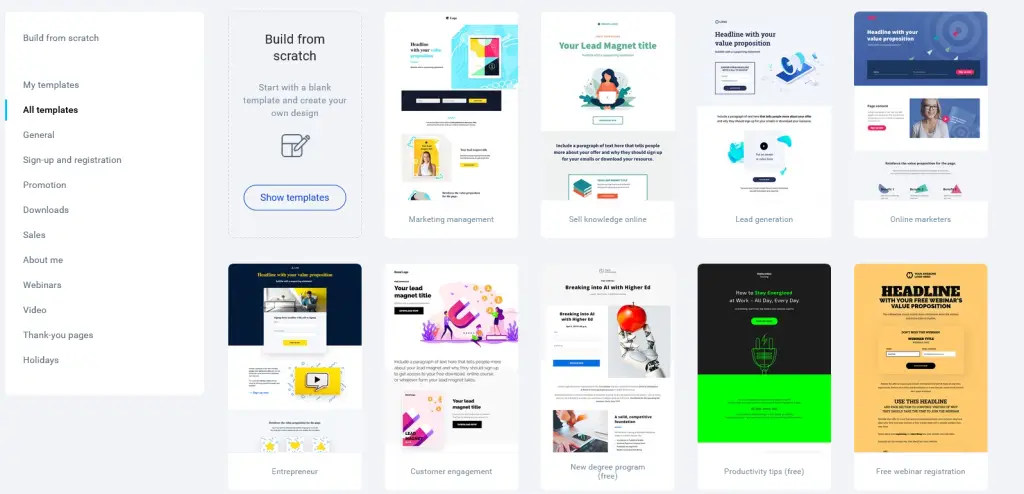
This section will discuss creating effective landing pages and forms using GetResponse. Landing pages are standalone pages designed to convert visitors into leads or customers, while forms are used to collect information from visitors.
5.1: Creating Landing Pages with GetResponse
GetResponse provides a range of customizable landing page templates that you can use to create landing pages that are tailored to your brand and your marketing goals. You can choose from various templates optimized for different purposes, such as lead generation, webinar registration, and product sales.
To create a landing page with GetResponse, choose a template and customize it using the drag-and-drop editor. You can add images, text, videos, and other elements to create a landing page that is visually appealing and effective at converting visitors into leads or customers.
5.2: Creating Forms with GetResponse
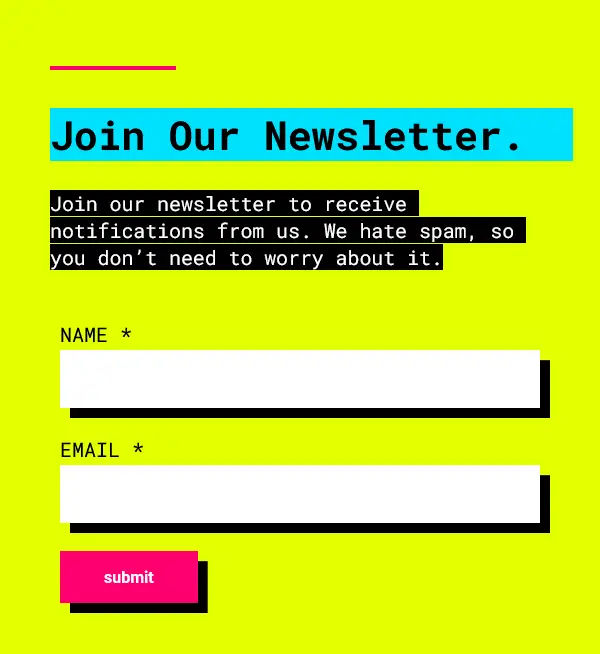
Forms are an essential part of any lead generation campaign, as they allow you to collect information from visitors that you can use to nurture them into customers. GetResponse provides a range of customizable form templates that you can use to create forms that are tailored to your brand and your marketing goals.
To create a form with GetResponse, choose a template and customize it using the drag-and-drop editor. You can add fields for name, email address, phone number, and other information you want to collect from visitors. You can also customize the design of the form to match your brand and make it more visually appealing.
5.3: A/B Testing Landing Pages and Forms
A/B testing is essential to optimizing your landing pages and forms for maximum conversions. With GetResponse, you can easily create two versions of a landing page or form and test them against each other to see which performs better.
To perform A/B testing with GetResponse, simply create two versions of your landing page or form and test them against each other using the A/B testing feature. You can then use the results to optimize your landing pages and forms for maximum conversions.
Landing pages and forms are essential components of any successful email marketing campaign. With GetResponse, you can easily create effective landing pages and forms tailored to your brand and marketing goals. By following the tips and strategies outlined in this section, you can easily optimize your landing pages and forms for maximum conversions and achieve your business goals.
6. E-commerce Tools
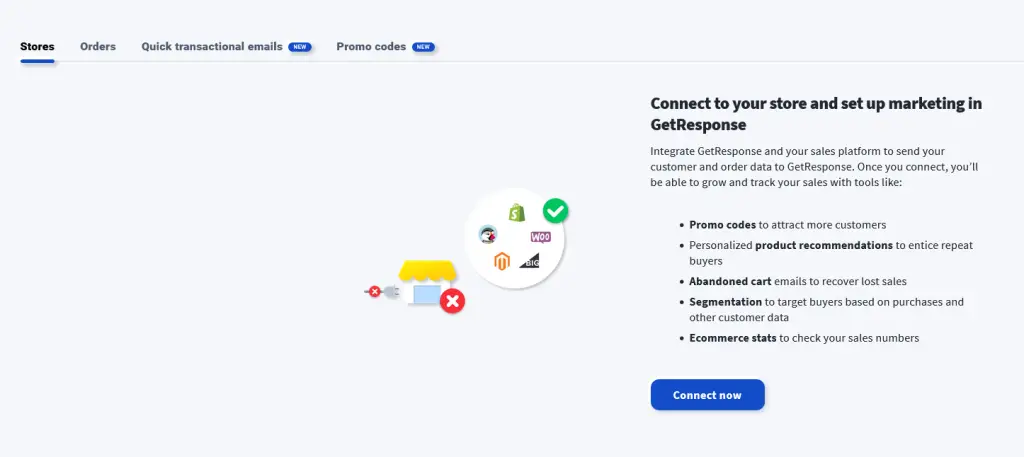
We'll explore the e-commerce tools that GetResponse offers to help you sell your products and services online.
6.1: Product Listings
GetResponse allows you to create and manage product listings directly within the platform. You can easily upload product images, descriptions, and pricing information to showcase your products to potential customers.
By utilizing product listings, you can make it easier for your customers to browse and purchase your products while also streamlining the buying process for yourself.
6.2: Abandoned Cart Emails
Abandoned cart emails are a powerful tool for e-commerce businesses to recover lost sales. With GetResponse, you can automate sending abandoned cart emails to customers who have left items in their shopping cart without completing the purchase.
By reminding customers of their abandoned carts and offering incentives to complete the purchase, you can increase your chances of recovering lost sales and boosting your revenue.
6.3: Upsell and Cross-Sell Emails
Upsell and cross-sell emails are other powerful e-commerce tool that can help you increase your revenue. With GetResponse, you can automate sending upsell and cross-sell emails to customers based on their purchase history and behavior.
By recommending related products and offering to upsell options, you can increase the average order value and generate more revenue from each customer.
6.4: Integrations with E-commerce Platforms
GetResponse offers integrations with various popular e-commerce platforms, including Shopify, WooCommerce, and Magento. By integrating your e-commerce platform with GetResponse, you can streamline your marketing and sales processes while gaining valuable insights into your customers' behavior and preferences.
E-commerce tools offered by GetResponse can help you streamline your marketing and sales processes, recover lost sales, and increase your revenue. By utilizing product listings, abandoned cart emails, upsell and cross-sell emails, and integrations with popular e-commerce platforms, you can optimize your e-commerce strategy for success.
7. Analytics and Reporting
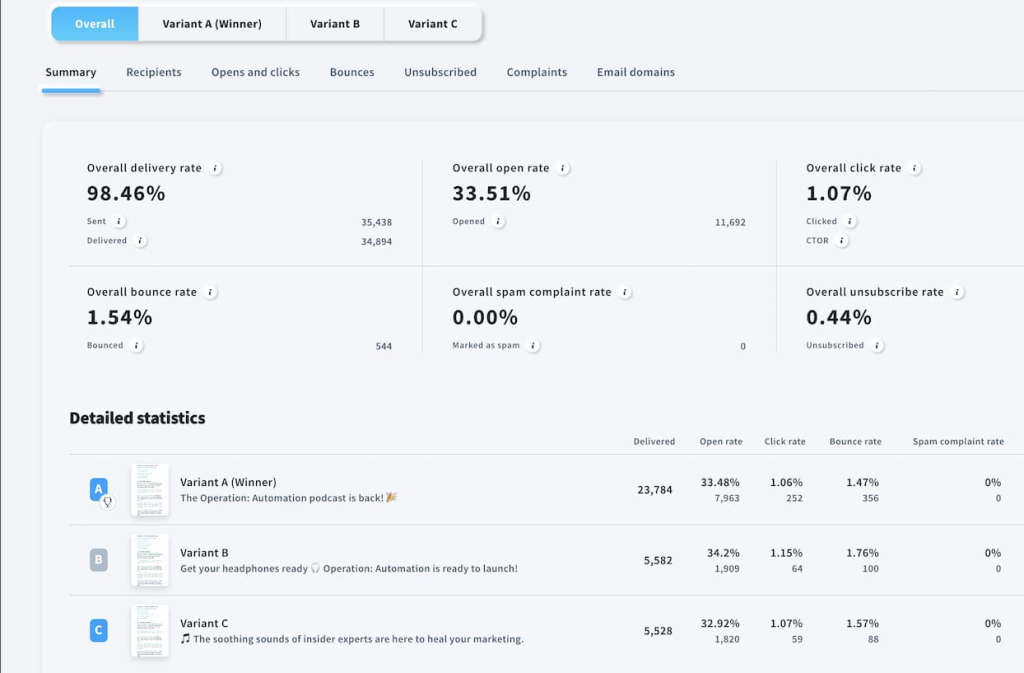
In this section, we'll explore the analytics and reporting features offered by GetResponse, which can help you track and optimize the performance of your email campaigns.
7.1: Performance Analysis
GetResponse provides detailed performance analysis for your email campaigns, including open rates, click-through rates, conversion rates, and more. By analyzing this data, you can identify what's working and what's not and make informed decisions about how to optimize your campaigns for better results.
7.2: A/B Testing
A/B testing is a powerful tool for optimizing your email campaigns. With GetResponse, you can easily create and test different variations of your emails, such as subject lines, content, and images. By testing different variations and analyzing the results, you can identify the most effective elements and optimize your campaigns accordingly.
7.3: List Management
Effective list management is crucial for the success of your email campaigns. GetResponse provides tools for managing your email lists, including segmenting your lists based on subscriber behavior and preferences and cleaning your lists to remove inactive or unengaged subscribers.
By effectively managing your email lists, you can improve the relevance and engagement of your campaigns, which can lead to higher open and click-through rates.
7.4: Automated Workflows
Automated workflows are a powerful tool for optimizing email campaigns and improving customer experience. With GetResponse, you can easily create and automate workflows based on subscriber behavior, such as welcome series, abandoned cart follow-ups, and more.
By automating your workflows, you can provide a more personalized and timely experience for your subscribers, leading to higher engagement and conversions.
In conclusion, the analytics and reporting features offered by GetResponse can help you track and optimize the performance of your email campaigns. By utilizing performance analysis, A/B testing, list management, and automated workflows, you can improve the relevance and engagement of your campaigns, as well as increase your conversions and revenue.
8: Integrations and Third-Party Apps
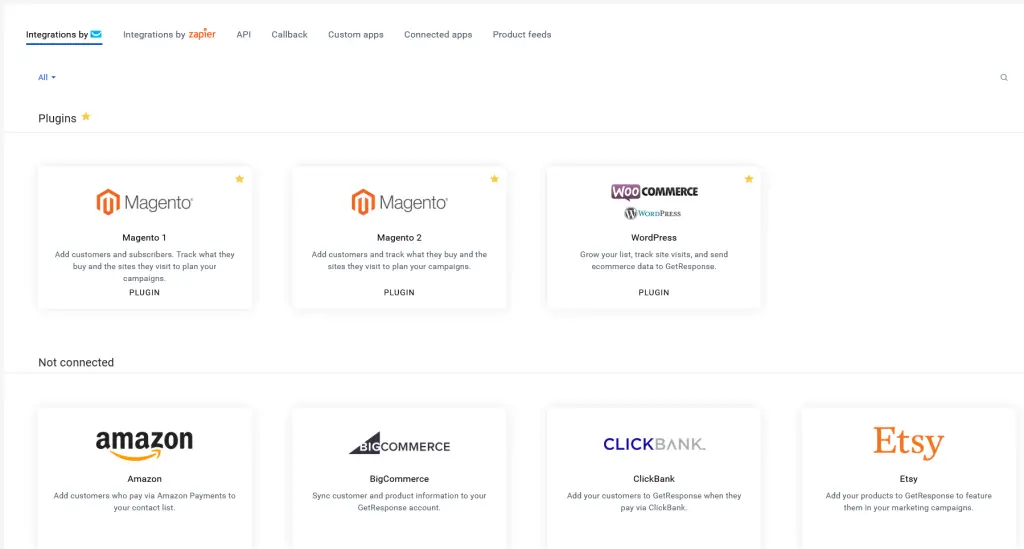
GetResponse offers a variety of integrations with third-party apps and services, which can help you streamline your marketing processes and improve your overall efficiency.
8.1: CRM Integrations
GetResponse integrates with several popular CRM (customer relationship management) tools, such as Salesforce, HubSpot, and Zoho CRM. By integrating your CRM with GetResponse, you can streamline your lead management and sales processes and improve your overall customer experience.
8.2: E-commerce Integrations
GetResponse also offers integrations with popular e-commerce platforms, such as Shopify, WooCommerce, and BigCommerce. By integrating your e-commerce platform with GetResponse, you can streamline your email marketing and sales processes and improve your overall customer experience.
8.3: Social Media Integrations
GetResponse also offers integrations with several popular social media platforms like Facebook, Twitter, and Instagram. By integrating your social media accounts with GetResponse, you can easily share your email campaigns and content with your followers and track your social media engagement and performance.
8.4: Other Integrations
GetResponse offers integrations with third-party apps and services, such as Zapier, PayPal, and Eventbrite. Integrating these apps with GetResponse allows you to automate your marketing processes and improve your overall efficiency.
Integrations and third-party apps offered by GetResponse can help you streamline your marketing processes and improve overall efficiency. By integrating with popular CRM, e-commerce, social media, and other apps and services, you can improve your lead management, sales processes, customer experience, and more.
9. GetResponse pricing

GetResponse offers a variety of pricing plans to fit the needs and budgets of different businesses. Let's look at the available plans and what they offer.
9.1: Basic Plan
The Basic Plan is the most affordable option, starting at $19 monthly for up to 1,000 subscribers. This Plan includes email marketing, autoresponders, landing pages, and basic automation workflows.
9.2: Plus Plan
The Plus plan costs $59 per month for up to 1,000 subscribers. This Plan includes all the features of the Basic Plan, plus more advanced automation workflows, webinars for up to 100 attendees, and sales funnels.
9.3: Professional Plan
The Professional Plan starts at $119 monthly for up to 1,000 subscribers. This Plan includes all the features of the Plus plan, plus on-demand webinars, unlimited sales funnels, and paid webinars for up to 300 attendees.
9.4: Max Plan
The Max plan is the most advanced option, with customized pricing based on your needs. This Plan includes all the features of the Professional Plan, plus dedicated support, transactional emails, and deliverability consulting.
GetResponse offers a variety of pricing plans to fit the needs and budgets of different businesses. The Basic Plan is the most affordable option, while the Plus, Professional, and Max plans offer more advanced features and capabilities. Depending on your needs and budget, there is a GetResponse plan that can help you grow your business and achieve your marketing goals.
10. Conclusion
GetResponse is the ultimate email marketing solution for businesses of all sizes. With a range of features including email templates, list management, marketing automation, and performance analysis, GetResponse can help you create and send high-performing email campaigns that convert. By following the tips and strategies outlined in this guide, you can take your email marketing efforts to the next level and achieve your business goals with ease.
11. FAQ
What is GetResponse?
GetResponse is an all-in-one marketing platform that enables businesses to create, send, and track email campaigns, as well as manage their subscriber lists, automate their marketing processes, and optimize their sales funnels.
How can GetResponse help my business?
GetResponse can help your business by saving time and resources through marketing automation, improving your ROI through advanced analytics and A/B testing capabilities, and engaging your customers and prospects through effective email marketing campaigns.
How do I get started with GetResponse?
Getting started with GetResponse is easy. Simply sign up for a free trial account and start exploring the platform's features and functionalities.
What are some of the key features of GetResponse?
Some of the key features of GetResponse include email marketing, marketing automation, list management, subject lines, performance analysis, automated workflows, sales funnels, landing page creation, and more.
Is GetResponse user-friendly?
Yes, GetResponse is known for its user-friendly interface and intuitive workflows that make it easy for users of all skill levels to create effective email campaigns and marketing automation workflows.

